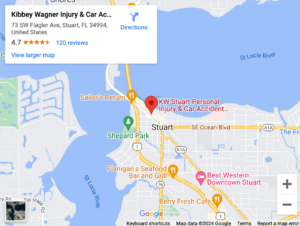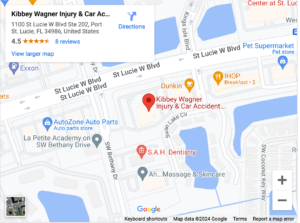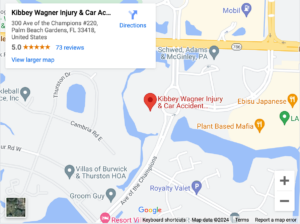
If you have been injured in an accident, you have a legal right to seek financial compensation from the party at fault for your injuries. As the injured victim, however, you’ll have the initial burden of proof to support your claim with evidence.
You’ll also have to make sure your evidence is persuasive enough according to the appropriate burden of proof standard.
Continue reading to learn more about the burden of proof and how it works in personal injury cases.
What Is a Burden of Proof?

In a personal injury case, the plaintiff (injured victim) has the initial burden of proof to support their contentions with evidence. They must do so by a “preponderance of the evidence,” which is the applicable burden of proof standard.
In other words, it must be more likely than not that the defendant is responsible for the plaintiff’s damages. If chances are greater than 50% that a defendant’s negligence caused the plaintiff’s injuries, a judge or jury can find in favor of the plaintiff and award money damages.
In a criminal case, the standard is “beyond a reasonable doubt”, or close to 100% certainty. This is a much stronger standard than what is required for personal injury cases.
A third important burden of proof standard is called “clear and convincing evidence.” This standard is easier to satisfy than “beyond a reasonable doubt,” but more difficult than “by a preponderance of the evidence.” This standard might apply if you are seeking punitive damages for your personal injury claim.
Elements of a Negligence Claim
Most personal injury cases are founded on a negligence cause of action. There are four legal elements required to prove negligence:
- Duty of Care. “Duty of care” is the responsibility each of us share to act in a way that is reasonably safe and avoids danger to others. This is a duty to act in a way that avoids foreseeable problems. For example, fixing a broken step on your porch prevents others from tripping and falling. Failing to fix it causes a foreseeable problem for others.
- Breach of Duty. When a defendant did not do as a reasonable person would or should have, they have breached their duty of care to others. For example, in a medical malpractice case, a provider’s failure to administer a medication properly or perform treatment that other doctors would have performed can show breach of duty.
- Cause. The plaintiff must show that the defendant’s breach of their duty of care caused their injuries. Put simply, the plaintiff must show that “but for” the defendant’s actions or inaction, the plaintiff would not have been harmed. As part of this, they must show there was no intervening or separate cause for their injuries.
- Damages. When the first three elements are met, plaintiffs must show that they suffered damages as a result of the defendant’s breach of duty. Damages cannot be hypothetical or purely speculative. Typically, there are economic damages (hospital bills, property damage costs, lost wages, and costs for therapy) and non-economic damages such as emotional distress as well as pain and suffering.
Nearly all personal injury claims must prove these four elements. In some cases, however, strict liability applies instead, and a defendant can be held liable without proving negligence or intent.
Dog bite injuries in Florida are a common example, as the dog owner is responsible for injuries caused in public places or on another’s property. Other examples include product liability due to defective products and abnormally dangerous activities (firing guns, setting off fireworks, or engaging in illegal acts, for example).
Even if your case seems simple to you, it might not appear that way to a judge or jury until you assemble proof that meets the elements of negligence.
What Evidence Can a Plaintiff Use To Meet Their Burden of Proof?
To demonstrate negligence and meet their burden of proof, an accident victim needs evidence that can be admissible in court.
Some common examples include:
- Documentation. Documents in a personal injury case can take many forms but usually include police reports (technically inadmissible in court but still useful), medical bills, invoices for property damage repairs, car damage estimates, proof of lost wages, medical reports and opinions, and other professionally-produced materials showing the harm done.
- Accident scene evidence. Photos from a crash site, physical evidence recovered from the scene, video and surveillance footage, bodycam video from police officers, and other firsthand evidence of an accident play crucial roles in a personal injury case. A plaintiff and their attorney must obtain this evidence as soon as they can and use it to build their case.
- Eyewitness testimony. Critical testimony from witnesses to an accident can make or break a case. Waiting too long to start your case can mean losing access to critical witnesses who could testify on your behalf. Witnesses can turn a “he said, she said” case into a strong and successful claim for the plaintiff.
- Expert testimony. Experts such as doctors, therapists, and crash scene investigators can help a jury understand what happened and why your injuries deserve greater compensation. It is hard to know where to begin when seeking experts, but an experienced personal injury attorney will know who to contact as part of a successful claim.
Many other forms of evidence might be brought as well, depending on the case.
Start Your Case With an Experienced Stuart Personal Injury Attorney
A winning case strategy starts at the earliest stages, and each step is critical for an accident victim to maximize their financial recovery. Our skilled and experienced Kibbey Wagner Injury & Car Accident Lawyers can analyze your claim, assemble evidence, and help you meet your burden of proof. Call today at (772) 444-7000 for a free consultation to learn more.




